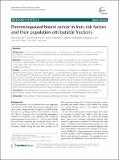| dc.contributor.author | Ghiasvand, Reza | |
| dc.contributor.author | Bahmanyar, Shahram | |
| dc.contributor.author | Zendehdel, Kazem | |
| dc.contributor.author | Tahmasebi, Sedigheh | |
| dc.contributor.author | Talei, Abdolrasoul | |
| dc.contributor.author | Adami, Hans-Olov | |
| dc.contributor.author | Cnattingius, Sven | |
| dc.date.accessioned | 2013-04-25T18:16:01Z | |
| dc.date.issued | 2012 | |
| dc.identifier.citation | Ghiasvand, Reza, Shahram Bahmanyar, Kazem Zendehdel, Sedigheh Tahmasebi, Abdolrasoul Talei, Hans-Olov Adami, and Sven Cnattingius. 2012. Postmenopausal breast cancer in Iran; risk factors and their population attributable fractions. BMC Cancer 12:414. | en_US |
| dc.identifier.issn | 1471-2407 | en_US |
| dc.identifier.uri | http://nrs.harvard.edu/urn-3:HUL.InstRepos:10587970 | |
| dc.description.abstract | Background: Causes of the rapidly increasing incidence of breast cancer in Middle East and Asian countries are incompletely understood. We evaluated risk factors for postmenopausal breast cancer and estimated their attributable fraction in Iran. Methods: We performed a hospital-based case–control study, including 493 women, diagnosed with breast cancer at 50 years or later between 2005–2008, and 493 controls. We used logistic regression models to estimate multivariable odds ratios (OR) and 95% confidence intervals (CI), and population attributable fractions (PAF) for significant risk factors. Results: The risk of breast cancer decreased with increasing parity. Compared with nulliparous women, the adjusted OR (95% CI) was 0.53 (0.25-1.15) for parity 1–3, 0.47 (0.29-0.93) for parity 4–6 and 0.23 (0.11-0.50) for parity ≥7. The estimated PAF for parity (<7) was 52%. The positive association between body mass index (BMI) and breast cancer risk was confined to women diagnosed at 58 years or later. Compared with normal weight women (BMI 18.5-24.9), overweight (BMI 25–29.9) and obese (BMI ≥30) women were at increased risk of breast cancer diagnosed at 58 years or later (ORs [95% CI] 1.27 [0.97-2.65] and 2.34 [1.33-4.14], respectively). The estimated PAF for obesity/overweight (BMI >25) was approximately 25%. The family history was significantly associated with increased breast cancer risk, but not increasing height, early age at menarche, late age at first birth or short breastfeeding. Conclusions: Decreasing parity and increasing obesity are determinants of increasing breast cancer incidence among Iranian women. These trends predict a continuing upward trend of postmenopausal breast cancer. | en_US |
| dc.language.iso | en_US | en_US |
| dc.publisher | BioMed Central | en_US |
| dc.relation.isversionof | doi:10.1186/1471-2407-12-414 | en_US |
| dc.relation.hasversion | http://www.ncbi.nlm.nih.gov/pmc/articles/PMC3517420/pdf/ | en_US |
| dash.license | LAA | |
| dc.subject | Breast neoplasm | en_US |
| dc.subject | Postmenopausal | en_US |
| dc.subject | Middle East | en_US |
| dc.subject | Risk factor | en_US |
| dc.subject | Attributable fraction | en_US |
| dc.title | Postmenopausal breast cancer in Iran; risk factors and their population attributable fractions | en_US |
| dc.type | Journal Article | en_US |
| dc.description.version | Version of Record | en_US |
| dc.relation.journal | BMC Cancer | en_US |
| dash.depositing.author | Adami, Hans-Olov | |
| dc.date.available | 2013-04-25T18:16:01Z | |
| dc.identifier.doi | 10.1186/1471-2407-12-414 | * |
| dash.contributor.affiliated | Adami, Hans-Olov | |


